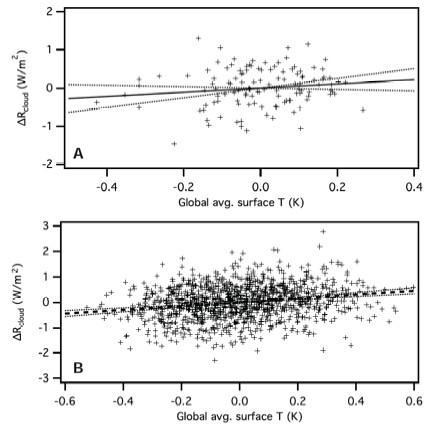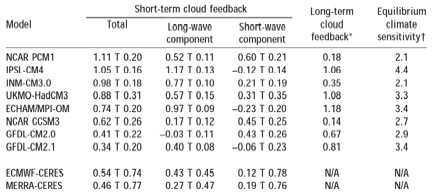An Even Cloudier Outlook for Low Climate Sensitivity
Posted on 12 December 2010 by dana1981
Research has given us good confidence that if CO2 doubles in the atmosphere then there will be 1.2°C of directly CO2-caused global warming, and a combination of melting snow/ice and increased evaporation of water will act as positive feedbacks to increase this warming by approximately 1 to 2°C.
This climate sensitivity of an additional 1 to 2°C warming would mean most recent global warming was human-caused and more is in the pipeline; but some scientists believe that changes in clouds will cool us down, though the most public paper to claim this (Lindzen and Choi 2009) has been heavily criticized for using a method that can be fiddled to give any desired result and ignores much of the planet.
The strength of the cloud feedback is commonly calculated by determining the change in cloud-caused heat flow for a change in temperature:
F = ?Rcloud /?Ts
Where "F" is cloud feedback, ?Rcloud is the change in the top of the atmosphere (TOA) flux caused by cloud changes, and ?Ts is the global-average and monthly mean surface temperature anomaly.
Roy Spencer believes these calculations are invalid because we can’t tell whether the warming is changing the clouds or the clouds cause the warming through his hypothesized ‘internal radiative forcing’. If the change in temperature is caused by the clouds in the first place, then we could calculate a positive feedback even if it is actually negative!
A new paper by Dessler (2010) attempts to get around this and calculate the quick cloud feedback using measurements by the Clouds and the Earth’s Radiant Energy System (CERES) instruments from March 2000 to February 2010. The satellite measures how much heat is coming from the Earth at TOA, and Dessler accounts for greenhouse gases, humidity, El Niño Southern Osciallation (ENSO), etc. to determine how much of the heat flow is from clouds. He then looks at how far above or below the average it is for its month, and plots this against temperature.
If the temperature is related to clouds, then you expect a slope in the graph thanks to the above formula. Figure 1 displays the results, and Dessler finds that the short term feedback is 0.54 ± 0.74 (2?) W m-2 K-1, i.e. far more likely to be positive than negative, although negative values can’t be ruled out based on this data. However, a small negative feedback is insufficient to support the theory that clouds will prevent significant future warming.

Figure 1: (A) Scatter plot of monthly average values of ?Rcloud vs. ?Tsusing CERES and ECMWF interim data. (B) Scatter plot of monthly averages of the same quantities from 100 years of a control run of the ECHAM/MPIOM model. In all plots, the solid line is a linear least-squares fit and the dotted lines are the 2? confidence interval of the fit.
A key point in the paper is that most of these short-term temperature changes are caused by ENSO. If the temperature change is being caused by ENSO, then it’s likely not being caused by clouds, and Spencer’s hypothesis is potentially sidestepped. Spencer has countered this by arguing that ENSO changes are caused by clouds, and thus the response of clouds to surface temperature changes cannot be inferred. Dessler argues that Spencer's hypothesis that ENSO is caused by clouds is new and untested, and the burden of proof falls on Spencer to demonstrate that his hypothesis is correct.
Dessler (2010) adds confidence that the cloud feedback is not significantly negative, and various climate models are largely in agreement with the CERES observations., as illustrated in Table 1.
Table 1: Cloud feedback values. All uncertainties are 2?. Feedbacks are calculated from a 100-year segment of a control run, except for CCSM3, which is based on 80 years.

Dessler is careful to point out that there are differences between short-term and long-term cloud feedbacks in models, which suggests that these observations might not be a good guide for the future. However, although long-term climate sensitivity cannot be determined from 10 years worth of data, the global climate models did pass this test, and the evidence against a strong negative cloud-climate feedback continues to mount.
The paper also comes on the heels of Lauer et al. (2010), which examined and provided support for the high end of current estimates of global climate sensitivity due to a positive cloud-climate feedback.
This guest post was written by Mark Richardson (MarkR) and Dana Nuccitelli (dana1981)































 Arguments
Arguments






























jump all over youcorrect you when they think you're wrong.